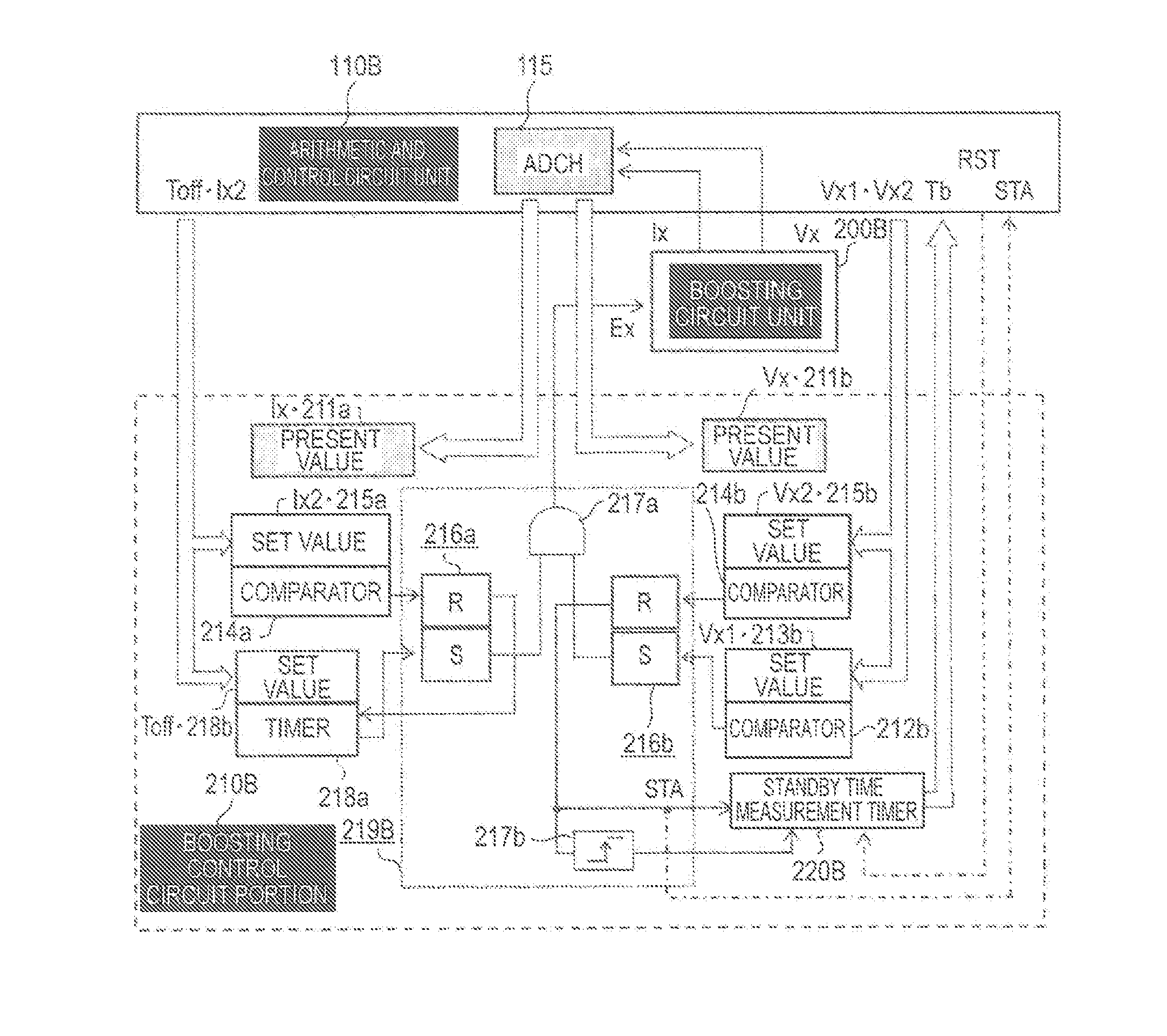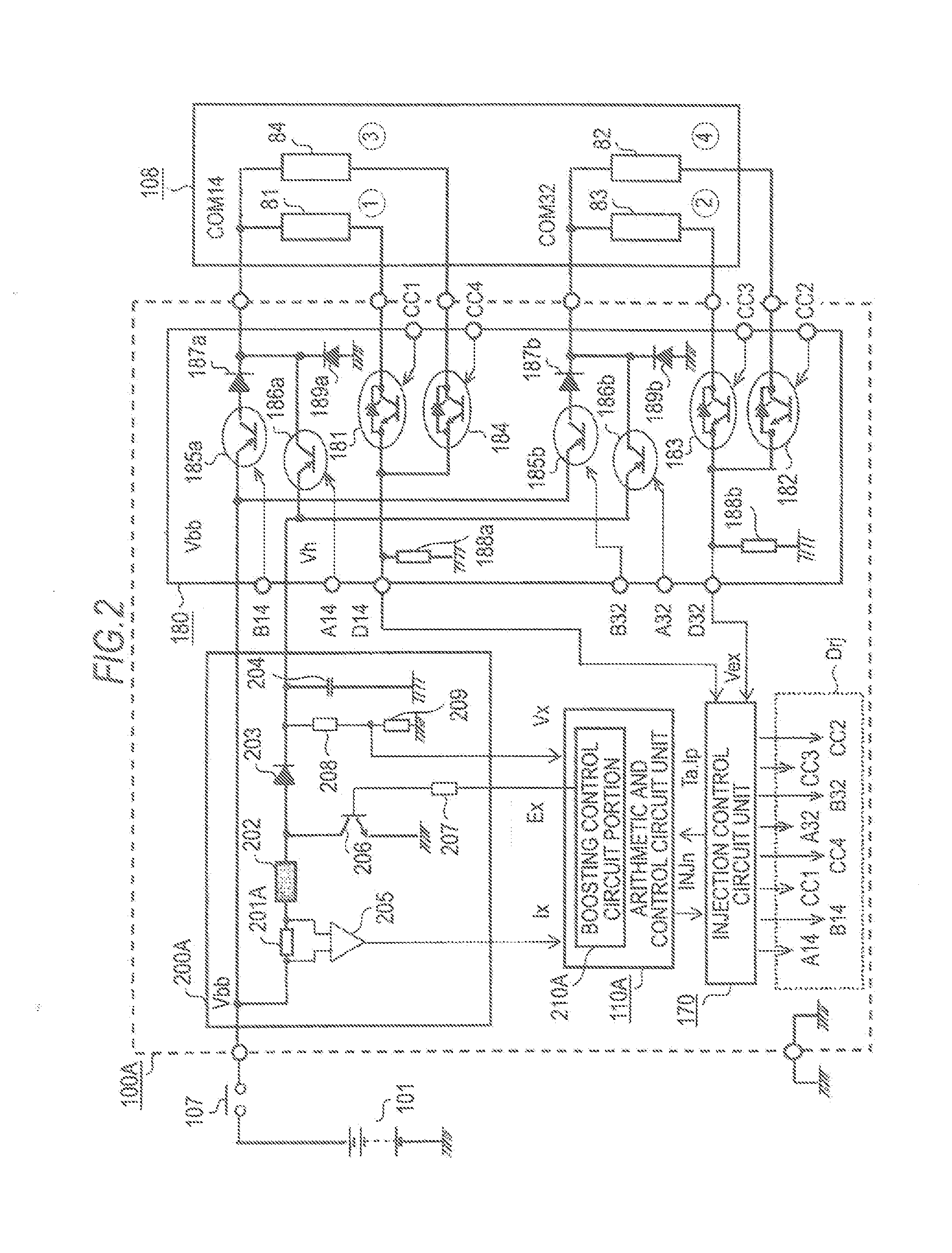In-vehicle engine control device and control method thereof
a technology of in-vehicle engine and control device, which is applied in the direction of electrical control, process and machine control, etc., can solve the problems of inability to suppress the increase in temperature of inductive element, difficulty in detecting peak current detection error, and fluctuation of fuel injection characteristic, etc., to achieve stable fuel injection characteristic, easy to variably set, and high-speed control burden
- Summary
- Abstract
- Description
- Claims
- Application Information
AI Technical Summary
Benefits of technology
Problems solved by technology
Method used
Image
Examples
embodiment 1
(3) Main Points and Features of Embodiment 1
[0069]As is clear from the above description, an in-vehicle engine control device according to Embodiment 1 of this invention is an in-vehicle engine control device 100A including an solenoid valve driving control circuit unit 180 for a plurality of electromagnetic coils 81 to 84 for driving solenoid valves in order to sequentially drive the solenoid valves 108 for fuel injection provided in respective cylinders of a multi-cylinder engine; a boosting circuit unit 200A which generates a boosted high voltage Vh for performing rapid excitation on the electromagnetic coils 81 to 84; an arithmetic and control circuit unit 110A which has a microprocessor 111 as a main constituent element; and an injection control circuit unit 170 which performs relay between the microprocessor 111 and the solenoid valve driving control circuit unit 180. The arithmetic and control circuit unit 110A includes a multi-channel A / D converter 114a operated at low speed...
embodiment 2
(3) Main Points and Features of Embodiment 2
[0093]As is clear from the above description, an in-vehicle engine control device according to Embodiment 2 of this invention is an in-vehicle engine control device 100B including an solenoid valve driving control circuit unit 180 for a plurality of electromagnetic coils 81 to 84 for driving solenoid valves; a boosting circuit unit 200B which generates the boosted high voltage Vh for performing rapid excitation on the electromagnetic coils 81 to 84; an arithmetic and control circuit unit 110B which has a microprocessor 111 as a main constituent element; and an injection control circuit unit 170 performs relay between the microprocessor 111 and the solenoid valve driving control circuit unit 180, in order to sequentially drive fuel injection solenoid valves 108 provided in respective cylinders of a multi-cylinder engine. The arithmetic and control circuit unit 110B includes a multi-channel A / D converter 114a operated at low speed, which coo...
embodiments 1 and 2
Main Points and Features of Embodiments 1 and 2
[0105]As is clear from the above description, in an in-vehicle engine control method used for the in-vehicle engine control device according to Embodiment 1 or 2, the boosting control circuit portion 210A or 210B further includes a boosting period measurement timer 220A which measures a charging necessary time Tc after the valve opening command signals INJn (where n is 81 to 84) are generated until a charged voltage of the high-voltage capacitor 204 is reduced to the minimum voltage Vx0 due to rapid excitation for the electromagnetic coils 81 to 84 and arrives at the target higher-side voltage Vx2 through recharging, or a standby time measurement timer 220B which measures a charging allowance time Tb after the charged voltage arrives at the target higher-side voltage Vx2 until the next valve opening command signals INJn are generated. The program memory 113A or 113B cooperating with the microprocessor 111 includes a control program whic...
PUM
 Login to View More
Login to View More Abstract
Description
Claims
Application Information
 Login to View More
Login to View More - R&D
- Intellectual Property
- Life Sciences
- Materials
- Tech Scout
- Unparalleled Data Quality
- Higher Quality Content
- 60% Fewer Hallucinations
Browse by: Latest US Patents, China's latest patents, Technical Efficacy Thesaurus, Application Domain, Technology Topic, Popular Technical Reports.
© 2025 PatSnap. All rights reserved.Legal|Privacy policy|Modern Slavery Act Transparency Statement|Sitemap|About US| Contact US: help@patsnap.com



